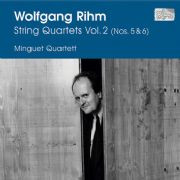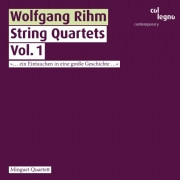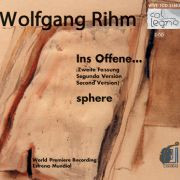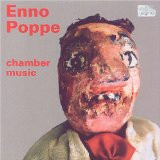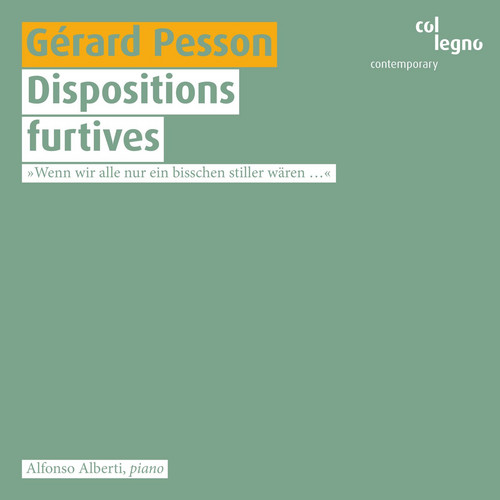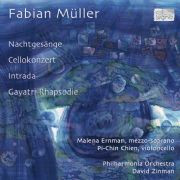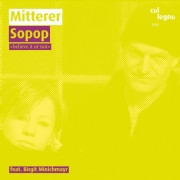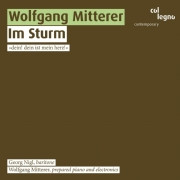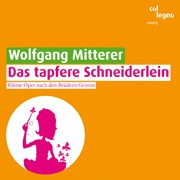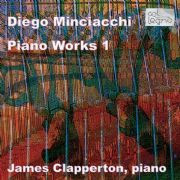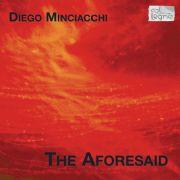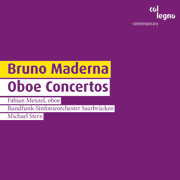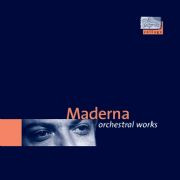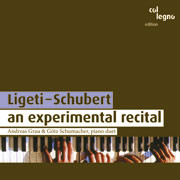★Col Legno
String Quartets Vol. 3 (Nos. 7-9)
String Quartets Nos. 7, 8 and 9 suggest that Rihm has finally left behind the neo-romantic expressive pathos of earlier compositions: “Real or virtual allusions to the past are rarely to be found any more – and the same holds of the luscious and revelling strings. Remnants of tonal harmony are, with a few exceptions, almost completely obliterated. … Instead, new constellations come to the fore, emancipated from traditional conceptions of sound – heeding, in particular, the principle of polarity …
String Quartets Vol. 2 (Nos. 5 & 6)
That the two single-movement string quartets No. 5 (“Ohne Titel”) and No. 6 (“Blaubuch”), composed in 1981/83 and 1984, belong to the most passionate of Rihm’s quartets is due to their restless vigor. This impulsive approach is of course always present in his music. But even the tempo indications “fast, restless” and “fast und free” suggest a certain stringency - which is fully realized in the pieces. A sense of inner disquiet pulls the listener like a maelstrom into a sea of commotion, of stru…
String Quartets Vol.1
This CD with … the first four string quartets reflects the interesting path of Rihm’s artistic development. The Minguet Quartet approaches the first two, shorter, works with audibly high concentration without relinquishing, in the frenzy of high-energy playing, their own cultivated sound born from quartet tradition. Here, Rihm’s third quartet, with its not unproblematic subtitle ‘Im Innersten’ (‘at the innermost core’), does not become self-indulgent navel-gazing, the display of sounding extremi…
Ins Offene... / sphere
Enclosing the listener in sonic space: This is what Beat Furrer carried to extremes in his FAMA (col legno 20612), about 15 years after Rihm, by actually placing his audience in a “building of sound”. For Wolfgang Rihm, a sonic space was something less concrete and more indirect: “Organically sprawling strings of sound should be woven around the listener, circling her from different directions. In this way, the listener is not left to her own devices while opening up to it; the piece itself come…
Chamber Music
Against spontaneity and con-sistency: Poppe manages the feat of being both a systematic and a revolutionary composer, one who plays by the rules and beats them at the same time.
Dispositions Furtives
Through the open sound portals created by his compatriot Castiglioni, the Italian pianist Alfonso Alberti first entered col legno's World of New Music; on his second album, he dedicates his sensitive and brilliant musicality to Gérard Pesson's fragile and puzzling fabrics of sound. A selection of piano pieces has been compiled in a joint effort by the pianist and the French composer; in his interpretations Alberti lets us catch glimpses of musical structures as though they were glittering just u…
a portrait
Karl-Heinz Stockhausen is only one out of several composers with whom the conductor Fabián Panisello has worked. Panisello, among others, has conducted the premiere of Stockhausen’s Hoch-Zeiten. Having studied with composers as diverse as Elliot Carter, Brian Ferneyhough and Luis de Pablo, Panisello was able to draw inspiration from them for his own compositional work, while never allowing them to leave visible footprints. His style developed entirely independently. The present recording brings …
Las Orillas
“It seems most important to me not to stop being a connoisseur; I freely confess that I would rather be considered a hedonist than an analyst.” This statement by Luis de Pablo is reflected in his music; not in violent yet superficial currents of sound but in finely differentiated sound as de Pablo’s Las Orillas (1990) demonstrates: “The composition is very linear, particularly in the slower parts. The orchestration has therefore been planned especially thoroughly such that each voice has a meani…
Nachtgesänge / Konzert für Violoncello und Orchester / Intrada /
Young Müller (b. 1964, Switzerland) writes in a consistently romantic style — unexpected col legno fare! Perhaps Sterling should have released this. The warm Hesse settings, Nachtgesänge, could be mistaken for Szymanowski or Zemlinsky; indeed, Ernman sounds as though she’d be ideal in a Strauss opera. Darkly emotional, the single-movement cello concerto taps Shostakovich and Lutoslawski’s pathos; the idée fixe’s colorful unfolding reminds the listener of Dutilleux. Müller maintains his anachroni…
Sopop
Wolfgang Mitterer, the acclaimed contemporary composer and great experimenter, has embarked on a journey into the world of pop, writing songs and lyrics and mixing whatever there is to mix. The new album produced by this cheerful commuter between musical genres provides the perfect sound for all locations, whether you're looking for underground music or tracks for your favorite techno clubbing, discotheque or jazz club. And the perfect sound, too, for actress Birgit Minichmayr, celebrated star o…
Im Sturm
Plunge into the world of Franz Schubert one more time, compose lieder full of "Storm and Stress," drenched with longing for love and world-weariness – Wolfgang Mitterer, the much-praised organist and composer specializing in electronic music, has written songs after Schubert. Now his cycle of lieder for baritone, prepared piano and electronics, entitled Im Sturm, "In the storm," also rages on CD. Naturally, this is a storm intermingled with undercurrents of irony, and an understanding of Romanti…
Das tapfere Schneiderlein
Drop the usual children's opera platitudes, add a liberal measure of cheek – result: a smart musical comedy, young and saucy, just like the brave little people that go about their business here. Do the children today know at all what this fairytale is about? Well, if they don't, Wolfgang Mitterer will bring it home to them, with just a few characteristic instruments: double bass, samples, synthetic sounds. Elisabeth Rombach as the little tailor takes to the road boldly and merrily, parading the …
Piano Works 1
Composer and neurologist Diego Minciacchi is as likely to publish a paper on motor skills as he is to compose music that mixes scientific and poetic ideas; yet this fact should not intimidate listeners new to his work, who might worry that the compositions on this 2005 release from Col Legno are too cerebral or complicated to appreciate. What they should know upfront, however, is that Minciacchi is a product of the generation of composers who absorbed the lessons of the 1960s and '70s avant-gard…
The Aforesaid
A professor of neurology at the University of Florence and one of Italy's foremost experimental composers, Diego Minciacchi creates fascinating music from raw scientific data and appends cryptic titles to his pieces that give them something of a whimsical, if not philosophical or mystical, context. The Aforesaid, Minciacchi's 2001 release on Col Legno, is a collection of five chamber works from the early '90s, a time when he found his voice and developed a feasible methodology in his works for v…
Playtime
Including Notturno volgare, for clarinet; Playtime No.1; Alex in Mongolia, for two guitars; Rite in progress, for piano; Notturno, for double bass; Playtime No.4; Dietro l'orologio, for soprano & tenor saxophones; Sei danze, for violin.
Donaueschinger Musiktage 2004
Unusually, the 2004 annual COL LEGNO release from the Donaueschinger Musiktage is devoted to the work of one composer, Englishman Benedict Mason, and to just one extensive and curiously-titled work, commissioned in 2001 by the German Südwestrundfunk. Specially written for the hall in Donaueschingen where this live recording of the work’s first performance was made, Mason’s music explores space and acoustic, as well as the character of a variety of instruments, to fascinating effect.
Oboe Concertos
The oboe more than suited Maderna's partiality for clear structures and sensual-concrete sounds. It was not without good reason that at a time when the supply of music dedicated to the oboe was anything but plenty, Maderna wrote, not one, not two, but three concertos (besides several other works for oboe) for this "nasal" sounding member of the woodwind family. The first oboe concerto (1963) seems almost classical in its character, in the interplay of oboe and orchestra, or involving other instr…
Orchestral Works
From this combination of ancient styles and arts of the past with contemporary music arises a series of particularly impressive works. In his Ausstrahlung, for instance, Maderna uses texts from an ancient Persian anthology and poems by various Persian authors in English, Italian, French and German translations, which are recited, sung and played from tape. Some ten years before, Maderna wrote the Konzert für Oboe und Kammerensemble out of fondness for the oboe. Another two concerts would follow …
An Experimental Recital
Some 150 years apart, both composers developed minute nuclei into an ever expanding cosmos of sound, each against the background of his own era. Prick up your ears – Schubert's Fantasy in F minor and Sonata in B flat major D 617 crossed with Ligeti's Three pieces for two pianos: rich in contrasts, upsetting, and in a simply stunning interpretation by Andreas Grau & Götz Schumacher. In the beginning there was simply the idea of playing Schubert and Ligeti together in one program: "During the perf…
Works for Piano and Cembalo
The pieces for piano/cembalo on this CD include the first two Capriccios by the 24-year-old Ligeti, the Musica ricercata, and the first volume of the legendary Études, in brilliant interpretations by the German pianist Erika Haase. Ligeti was a master in how to make tricky compositional systems appear as more than just that by inspiring them with sensual substance: that's what distinguishes the artist from the artisan. Throughout his life Ligeti kept his ears pricked up and his senses sharpened …

